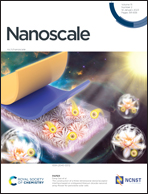DNA conformational equilibrium enables continuous changing of curvatures†
Abstract
Assembly of complex structures from a small set of tiles is a common theme in biology. For example, many copies of identical proteins make up polyhedron-shaped, viral capsids and tubulin can make long microtubules. This inspired the development of tile-based DNA self-assembly for nanoconstruction, particularly for structures with high symmetries. In the final structure, each type of motif will adopt the same conformation, either rigid or with defined flexibility. For structures that have no symmetry, their assembly remains a challenge from a small set of tiles. To meet this challenge, algorithmic self-assembly has been explored driven by computational science, but it is not clear how to implement this approach to one-dimensional (1D) structures. Here, we have demonstrated that a constant shift of a conformational equilibrium could allow 1D structures to evolve. As shown by atomic force microscopy imaging, one type of DNA tile successfully assembled into DNA spirals and concentric circles, which became less and less curved from the structure's center outward. This work points to a new direction for tile-based DNA assembly.

- This article is part of the themed collection: Emerging concepts in nucleic acids: structures, functions and applications


 Please wait while we load your content...
Please wait while we load your content...
